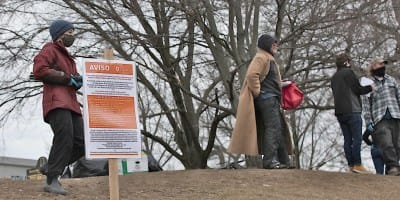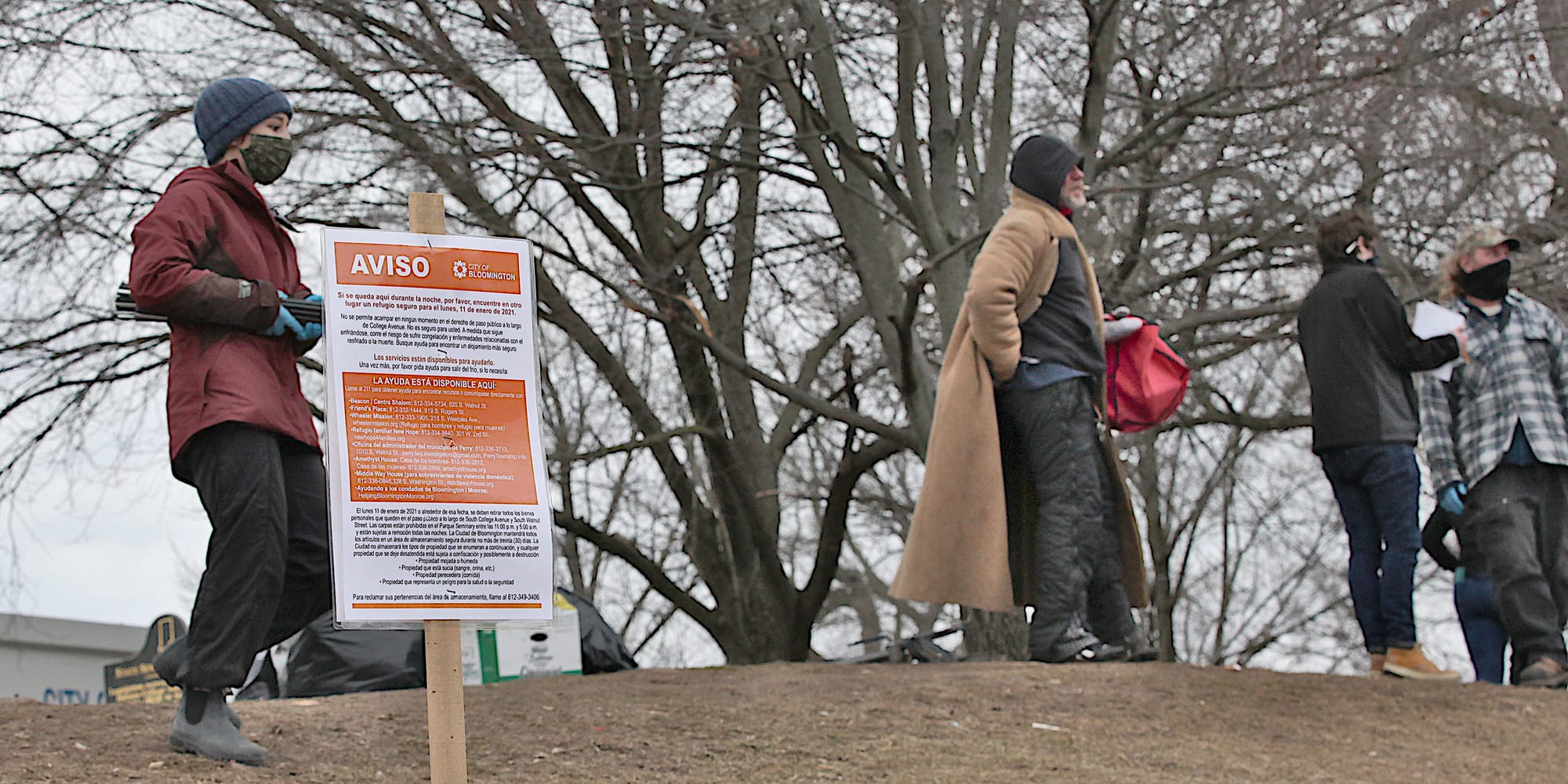Bloomington’s proposed law protecting encampments puts housing first: “We can’t shelter our way out of this problem.”


Set for Wednesday are the first round of the Bloomington city council’s deliberations on a proposed new law that would provide protections to encampments of houseless people in city parks.
The council could take a provisional vote, but there won’t be a vote on the question of enactment.
The law was proposed by city council sponsors Matt Flaherty, Kate Rosenbarger, and Isabel Piedmont-Smith, after a decision by Bloomington’s mayor, John Hamilton, to clear a Seminary Park encampment in early December and again in mid-January.
Highlights of the proposed new law include a requirement of 15-day notice before a camp displacement. Another requirement is that sufficient alternative housing be available for people living in the encampment.
A common thread in statements made in the past week, by some significant community players who oppose the law, is the idea that it is important to find longer-term solutions to the problems of homelessness.
The ordinance itself includes a longer-term perspective, because under the proposal, the city could not displace a camp unless there is sufficient available “permanent housing” or “transitional housing” as defined by federal HUD regulations.
That means emergency shelter does not count towards sufficient available housing, for the purpose of displacing an encampment.
It’s a point that could see some debate on Wednesday, because it’s seen as a potential argument both for and against the ordinance.
It’s the right approach for the ordinance to focus on housing, as contrasted with temporary shelter, according to Forrest Gilmore, CEO of Beacon, Inc. (formerly Shalom Community Center).
Gilmore worked with several partner agencies to add a 49-bed temporary shelter, which was opened few days after the second Seminary Park clearance.
But Gilmore puts it this way: “We can’t shelter our way out of this problem.”
Examples of existing permanent supportive housing, listed in HUD’s Continuum of Care (CoC) Housing Inventory Count (HIC) for Monroe County include: Centerstone’s Grant Street House and Beacon Inc.’s Crawford Homes and Johnson Homes projects, among others.
HUD’s Continuum of Care (CoC) Program is supposed to promote community-wide efforts to end homelessness.
About the issue of people camping in parks, Gilmore said, “If you don’t have access to private space, and you don’t have access to public space, you then are constantly outside of the law.” He continued, “So, in my opinion, it’s a constitutional right to access the public space which is at hand here, when you don’t have access to other accommodations.”
Gilmore added, “You can’t criminalize people for this.”
Glimore wrapped up the point: “It puts the obligation on us as a community to deal with a real solution, which is housing. I don’t think shelter always meets the needs that people have.”
For others, like Bloomington’s mayor John Hamilton, the requirement of available transitional or permanent housing, before an encampment can be cleared, makes for an argument against the ordinance.
The idea that housing, not mere temporary shelter, would have to be available for campers, before they could be displaced, is unrealistic, goes the argument—given the limited inventory of permanent supportive housing. That’s the line of reasoning that Hamilton followed in a letter he sent to councilmembers, which concludes, “The result, practically speaking, could likely be that any camps created could not be closed for the foreseeable future.”
Aside from the limited inventory, a practical hurdle that has to be cleared to place encampment residents into permanent or transitional housing, as opposed to shelters, is the concept of “coordinated entry.” It’s a way to prioritize people for placement in permanent supportive housing who are at the highest risk.
Though in some ways it is a hurdle, Dan McNeely, director of supportive housing for Centerstone, describes coordinated entry as the federal government’s effort to ensure that those who are chronically homeless, or who are in serious trouble, get top priority.
Centerstone is a not-for-profit health system providing mental health and substance use disorder treatments.
Any time there is a vacancy in one of the area’s permanent supportive housing facilities, a Continuum of Care committee—which includes Centerstone, Positive Link and Beacon, Inc.—reviews the vacancy at its next meeting, McNeely said. The subject of review is a list of names with scoring that’s generated based on an assessment, called the VI-SPDAT (Vulnerability Index–Service Prioritization Decision Assistance Tool).
When the highest-priority person is identified on the list, McNeely said, “We reach out to that person, start working on the admission process, getting the required stuff you have to have: proof of citizenship and driver’s license and social security number.” He added, “And once all that is in place, then they get that housing.”
Soon to be added to the area’s mix of permanent supportive housing will be the Kinser Flats project, which will be a 50-unit complex for people experiencing homelessness and with substance use disorders. It was hoped to open on Feb. 1. Now pushing towards the end of February, the project is still getting final details hammered out with contractors, according to McNeely.
Federal, state, and city of Bloomington money helped fund the project.
Ground was broken in late 2019, but McNeely said the process to construct Kinser Flats started over three years ago. “So it’s taken us three years to get from concept to having a building ready to lease,” McNeely said.
McNeely added, “That’s just the way permanent supportive housing gets built—it’s a long process.”
Centerstone hasn’t taken a position on the proposed ordinance, McNeely said.
About the ordinance, McNeely said there are few vacancies for transitional and permanent supportive housing in Monroe County. He added, “And in order to develop a lot more permanent supportive housing, we need a lot more organizations, applying for this lengthy and expensive process.”
Late last year and in the first weeks of the year, the city council has heard public commentary during its meetings calling for action in support of those who are experiencing homelessness. Word of an ordinance that was in the works has been a rallying point.
The Hamilton administration’s opposition to the law was apparent when it was first floated, at a city council work session in the third week of January.
At the work session, deputy mayor Mick Renneisen asked Flaherty, the lead sponsor: “So what’s the problem you’re trying to solve?” Flaherty responded: “I would say violations of our unhoused neighbors’ basic rights, for a start. For instance, being evicted from public space without notice, or with essentially no notice.”
In the last week, councilmembers have heard some additional significant opposition to the proposed ordinance.
In his message to councilmembers, Hamilton put in writing his opposition to the proposed new law. An email to councilmembers signed by Karen and John Fernandez—he served as Bloomington’s mayor from 1995 to 2003—also encouraged councilmembers to oppose the proposed law.
The Greater Bloomington Chamber of Commerce released a statement on Tuesday expressing opposition.
Table: HUD’s Continuum of Care (CoC) Housing Inventory Count (HIC) for Monroe County
| Category | Organization Name | Project Name | Total Beds |
| Emergency | Bloomington Catholic Worker | Hospitality | 7 |
| Emergency | Middle Way House, Inc. | Middle Way House Emergency Shelter | 32 |
| Emergency | New Hope Family Shelter | New Hope Family Shelter | 27 |
| Emergency | Shalom Community Center | Friend’s Place | 40 |
| Emergency | Warming Shelter (Referral and Emergency Services) | Winter Contingency | 8 |
| Emergency | Wheeler Mission Ministries, Inc. | Agape House (Center for Women & Children) | 22 |
| Emergency | Wheeler Mission Ministries, Inc. | Center for men | 130 |
| Emergency Total | 266 | ||
| Permanent | Centerstone | Bloomington Permanent | 10 |
| Permanent | Centerstone | Grant Street House SRO | 12 |
| Permanent | Centerstone | Limestone PSH (Old Hoosier House) | 10 |
| Permanent | City of Bloomington | VASH – Bloomington Housing Authority | 104 |
| Permanent | IU Health – Bloomington Hospital | Housing Links | 12 |
| Permanent | IU Health – Bloomington Hospital | IU Health Bridges | 21 |
| Permanent | Shalom Community Center | Crawford Homes | 48 |
| Permanent | Shalom Community Center | Crawford/Johnson Section 8 | 10 |
| Permanent | Shalom Community Center | Davis Homes PH | 32 |
| Permanent | Shalom Community Center | Johnson Homes | 38 |
| Permanent Total | 297 | ||
| Rapid Rehousing | Shalom Community Center | Rapid Rehousing – BOS (ESG) | 48 |
| Rapid Rehousing Total | 48 | ||
| Transitional | Blue River Services | Jill’s House | 12 |
| Transitional | Middle Way House, Inc. | The Rise! | 128 |
| Transitional Total | 140 | ||
| Grand Total | 751 |




Comments ()